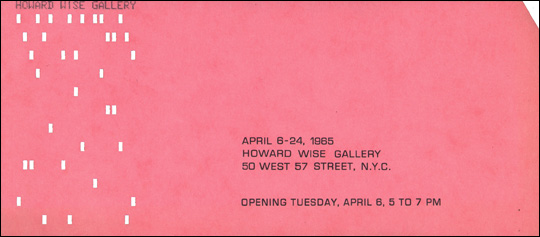
Single sided card / announcement printed on a pink computer punchcard--one from four issued--in conjunction with the show "Computer-Generated Pictures," held April 6 - 24, 1965. Exhibition organized by Bela Julesz and Michael Noll.
An exhibition of pictures conceived by two scientists, Bela Julesz and Michael Noll, and executed by IBM #7094 Digital Computer with the assistance of General Dynamics SC-4020 Microfilm Plotter, will be on view at the Howard Wise Gallery: opening April 6th.
Some of the pictures are in 2-D, others, when viewed stereoscopically through special glasses, supplied at the Gallery, are in 3-D. Some are in series, and give the illusion of viewing a sculpture from successive vantage points.
This exhibition demonstrates, to some small degree, the potentialities of the computer as a tool in the service of the artist. As computer technology progresses and costs come down, this technique will be more fully explored by the artist.
To produce a picture on a computer it is first necessary to formulate mathematically a means of determining an array of points, which when arranged in groups or connected by straight lines, will produce the desired pattern. Once these mathematical formulae have been obtained, they are punched onto standard IBM cards in the language understandable to the computer.
Following its "run", the computer records its output on magnetic tape. This information then instructs the microfilm printer to "draw" the finished pattern which appears on the face of a standard image orthicon tube. The pattern is photographed on 35 mm microfilm and the processed negative becomes the "original" picture. Prints are made by standard photographic techniques. This process also enables the originator to review the pattern, make any refinements he wishes and then run it again until a satisfactory result is obtained.
Presently, computer-generated pictures are limited solely by the state of the computer and microfilm art. Noll and Julesz see the day when a computer can draw - or paint - almost any kind of picture in any one or combination of colors.
Both scientists stress, however, that the artist need not fear being automated out of existence; rather, as they see it, the computer will free the artist for creation, unburdened by the tedium of the mechanics.
******
Bela Julesz was born in Hungary in 1928. Graduated from the Technical University of Budapest and the Hungarian Academy of Science, he taught and did research in communications systems. He came to the United States in 1956, where he devotes full time to visual research, particularly in depth perception and pattern recognition. "Texture and Visual Perception" by Julesz appeared in the February 1965 issue of Scientific American, the cover of which carries an illustration in color of one of his experiments.
Michael Noll was born in 1939 in Newark, New Jersey. He received his education at the Newark College of Engineering and New York University, and is currently working towards his Ph.D. at Polytechnic Institute of Brooklyn, as well as carrying on his research work in the field of communications. -- from exhibition''''s press release.